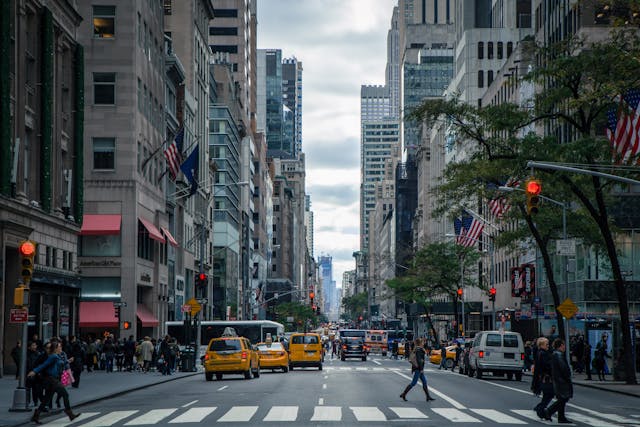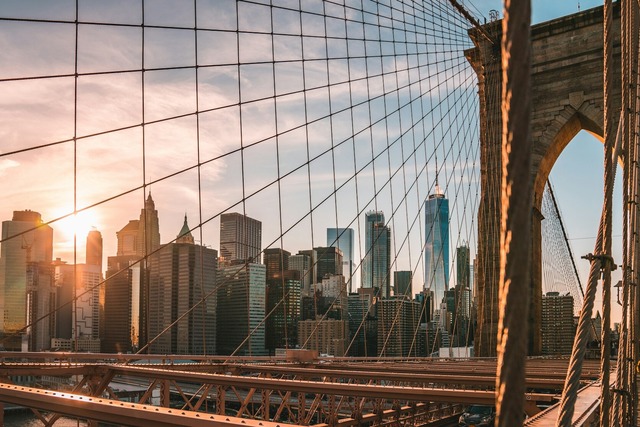New York Central Business District
New York City’s Central Business District, which encompasses Midtown and Downtown Manhattan, has been an influential economic and financial capital since the 19th century, mainly thanks to the presence of the New York Stock Exchange (NYSE) and other important financial institutions.
Today, it is the largest central business district in the United States, with a total area of 2.2 square miles.
Contents
Key Facts & Figures about NYC Central Business District
- The central business district consists of three sub-districts: Midtown, Midtown South, and Downtown, which are further divided into 18 sub-markets.
- There are approximately 190,000 small businesses, which employ more than 900,000 people.
- This area is home to 40 Fortune 500 corporations, the highest concentration in the country.
- The New York central business district was recently listed as the second best startup ecosystem in the nation and worldwide.
- The central business district has more than 617,000 residents and nearly 900,000 people commute into the area every day.
- Local companies attracted nearly $20bn in venture capital funding in 2023.
- In 2023, NYC attracted more than 62 million visitors per year, with business travelers accounting for 20% of the total.
Transportation
As central business districts go, New York City’s is very well connected to other parts of the city and boroughs like downtown Brooklyn and Long Island City via mass transit. The area is served by 18 subway lines and more than 40 bus lines, which work to keep the area accessible 24/7. All in all, the Metropolitan Transport Authority (MTA) serves more than 4.6 million passengers per day.
The PATH railway system links the central business district with Greater New York and New Jersey, offering frequent services to commuters and visitors. The WTC station alone had an annual ridership of 11 million passengers in 2023.
Airport connections are available directly to and from the New York CBD to La Guardia (bus and subway, 9 miles, 30 minutes), Newark (train and bus, 20 miles, 45 minutes), and JFK (train and bus, 14 miles, 1 hour).
However, NYC recently put an indefinite hold on its congestion plan, which was meant to levy tolls on vehicles entering and circulating the CBD from 61st Street and lower. The revenues collected from the congestion pricing program were expected to help improve and upgrade the existing mass transit system.

Key Industries & Employers
New York’s CBD is a global business hub that features a diverse industry base where every sector is present.
A Downtown Alliance report for 2023 lists the largest private sector employers in the city: Goldman Sachs, Morgan Stanley, Bank of New York, American Express, WeWork, Conde Nast, WPP Group, Sullivan & Cromwell, Spotify, and Cleary Gottlieb.
According to 2023 data, the most significant industries are:
- Banking and financial services: Despite job losses in these sectors and the exit of high-income residents, Manhattan retains its status as a global financial powerhouse that employs 500,000 people.
- Construction: The CBD construction sector set new monthly records in 2023 for permits filed and doubled the quarterly figures for 2020. Along with other major infrastructure projects, new office deliveries are planned in Hudson Yards, Park Avenue, and Madison Square.
- Technology: This sector provides 5% of all the city’s jobs, and has special strengths in SaaS and FinTech. Additionally, there are 52 NYC companies among North America’s 500 fastest-growing in the tech and life sciences.
- Professional and technical services: One of the core office-occupying industries, managed to retain comparatively stable employment numbers relative to pre-pandemic levels.
- Tourism: Approximately 9% of the city’s total jobs are in this sector, which is expected to increase its economic impact with planned improvements to all three airports.
Commercial Real Estate in New York’s Central Business District
Office Space
New York’s CBD is a prime real estate location. With nearly 540 million square feet, is also the largest in the country by area.
The main occupiers of office space in New York’s CBD are FIRE businesses (financial, insurance, and real estate), followed TAMI (technology, advertising, media, and information). In 2023, the most significant leases came from occupiers in these sectors and from professional business services firms.
The increased proliferation of remote and hybrid work models from 2020 onward has had a significant impact on the use and demand of corporate offices. In early 2023, 53% of CBD employees were back working from the office, although only 9% did so five days a week. The most common arrangement are hybrid schedules with 3 days in the office.
2023 data also shows marked differences between CBD sub-markets in the performance of asking rents. Whereas in Midtown and Midtown South rents started to increase after reaching record lows in 2021, in Lower Manhattan asking rates continue down to averages of $55 / sq ft. Offices in Park Avenue are attracting the most valuable deals, mostly by large legal firms.
Office space vacancy rates are still increasing post-pandemic at above 20% for all three CBD submarkets, but Class A properties continue to generate strong interest. These office buildings also have the highest midweek occupancy rates of around 80% of their pre-pandemic values.

Retail Space
There are approximately 56 million square feet of retail space in Manhattan and the adjacent CBD areas.
After significant losses and a generalized slowdown in 2020 and 2021, demand for top-quality retail commercial space returned, especially in the most prestigious sub-markets, such as Fifth Avenue, Soho, and Madison Avenue. The return to the office and higher weekday footfall are largely responsible for the recovery of retail activity.
Recovery is underway with strong demand in Soho, Union Square, and Flatiron, which were the best-performing markets in 2023. The Plaza District and the luxury corridor sub-markets also remained active throughout 2023. Apparel, F&B, home furnishings, financial services, and fine arts were the main drivers of retail activity.
Price-wise, there were slow but noticeable increases during 2023, recovering to averages of $1000 / sq ft.
Future Outlook
Looking ahead, analysts expect a rebound in the office space market along with demand for smaller office units in the 5,000 square feet range, as tenants continue to reduce their footprint. In the near future, the performance of the office market will also depend on landlords’ response to challenges like rising costs and compliance with ESG requirements.
Additionally, high-end retail in the CBD is expected to remain strong retaining its position as the priciest in the world.
Further Insights
Interested in learning more about what influences office space price and commercial real estate investment in key US markets? Or do you want to know about broad workspace trends in the United States? See down below for more of our most recent stories.
United States Commercial Property Prices Per Square Foot in 2024
Top Ten Largest CBDs in the USA
The Cost of Renting Office Space in Boston
Analyzing the Cost of Office Space in Washington DC
Commercial Real Estate Depreciation – How Does It Work?
NYC Office Space Rental: A Cost Analysis
Cost of Office Space in San Francisco vs LA Office Rental Prices
Mixed-Use Commercial Property: What You Need to Know
8 Benefits of In-Person Meetings: Meeting in Person vs Online
Remote Work Statistics: How Different Generations Feel About Working Remotely
